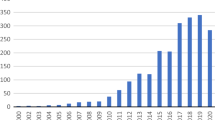Abstract
Adaptive designs have generated great interest in the clinical trial community as a result of their versatility and efficiency. Recently, the Center for Devices and Radiological Health (CDRH) at the US Food and Drug Administration (FDA) surveyed all adaptive design applications submitted between 2007 and May 2013 for regulatory review. In this paper, we discuss the overall results and findings that emerged from an in-depth examination of the submissions. We summarize the current status of adaptive designs used in medical device studies. We also identify some of the lessons learned and common pitfalls that we encountered in our review of the designs.
Similar content being viewed by others
References
Food and Drug Administration. Draft guidance for industry and Food and Drug Administration staff: adaptive designs for medical device clinical studies. Rockville, MD: FDA, 2015.
Pocock SJ. Group sequential methods in the design and analysis of clinical trials. Biometrika. 1977;64:191–199.
O’Brien PC, Fleming TR. A multiple testing procedure for clinical trials. Biometrics. 1979;35:549–556.
Lan KKG, DeMets DL. Group sequential procedures: calendar versus information time. Stat Med. 1987;8:1191–1198.
Proschan MA, Hunsberger SA. Designed extension of studies based on conditional power. Biometrics. 1995;51:1315–1324.
Cui L, Hung HM, Wang S. Modification of sample size in group sequential clinical trials. Biometrics. 1999;55:853–857.
Müller H, Schäfer H. Adaptive group sequential designs for clinical trials: Combining the advantages of adaptive and of classical group sequential approaches. Biometrics. 2001;57:886–891.
Chen YHJ, DeMets DL, Lan KKG. Increasing the sample size when the unblinded interim result is promising. Stat Med. 2004;23:1023–1038.
Gao P, Ware JH, Mehta C. Sample size re-estimation for adaptive sequential design in clinical trials. J Biopharm Stat. 2008;18:1184–1196.
Berry SM, Carlin BP, Lee JJ, et al. Bayesian Adaptive Methods for Clinical Trials. Boca Raton, FL: CRC Press; 2011.
Campbell G. Similarities and differences of Bayesian designs and adaptive designs for medical devices: a regulatory view. Stat Biopharm Res. 2013;5:356–368.
Morgan CC, Huyck S, Jenkins M, et al. Adaptive Design: Results of 2012 Survey on Perception and Use. Therapeutic Innovation & Regulatory Science. 2014;48:473–81.
Elsäßer A, Regnstrom J, Vetter T, et al. Adaptive clinical trial designs for European marketing authorization: a survey of scientific advice letters from the European Medicines Agency. Trials. 2014;15:383.
Lin M, Lee S, Zhen B, et al. CBER’s experience with adaptive design clinical trials. Therapeutic Innovation & Regulatory Science. 2015; September 16 online.
Shih W. Sample size re-estimation—journey for a decade. Stat Med. 2001;20:515–518.
Food and Drug Administration. Guidance for the use of bayesian statistics in medical device clinical trials. Rockville, MD: FDA, 2010.
Gelman A, Carlin J, Stern H, Dunson DB, Vehtari A, Rubin DB. Bayesian Data Analysis. Boca Raton, FL: CRC Press; 2014.
Pennello G, Thompson L. Experience with reviewing Bayesian medical device trials. J Biopharm Stat. 2008;18:81–115.
Campbell G. Bayesian statistics in medical devices: innovation sparked by the FDA. J Biopharm Stat. 2011;21:871–887.
Schulz KF, Altman DG, Moher D. CONSORT 2010 Statement: updated guidelines for reporting parallel group randomised trials. BMJ 2010;340:c332.
Moher D, Hopewell S, Schulz F, et al. CONSORT 2010 Explanation and Elaboration: updated guidelines for reporting parallel group randomised trials. BMJ. 2010;340:c869.
Detry M, Lewis L, Broglio K, et al. Standards for the design, conduct, and evaluation of adaptive randomized clinical trials, http://www.pcori.org/assets/Standards-for-the-Design-Conduct-and-Evaluation-of-Adaptive-Randomized-Clinical-Trials.pdf. Published 2012. Accessed March 15, 2012.
Author information
Authors and Affiliations
Corresponding author
Electronic supplementary material
Rights and permissions
About this article
Cite this article
Yang, X., Thompson, L., Chu, J. et al. Adaptive Design Practice at the Center for Devices and Radiological Health (CDRH), January 2007 to May 2013. Ther Innov Regul Sci 50, 710–717 (2016). https://doi.org/10.1177/2168479016656027
Received:
Accepted:
Published:
Issue Date:
DOI: https://doi.org/10.1177/2168479016656027




